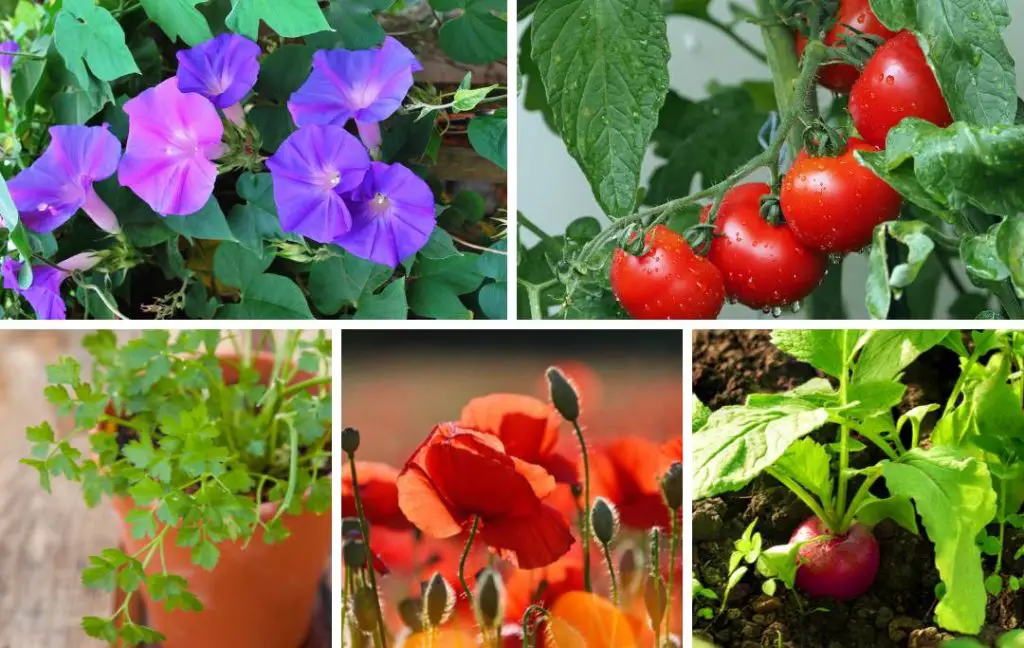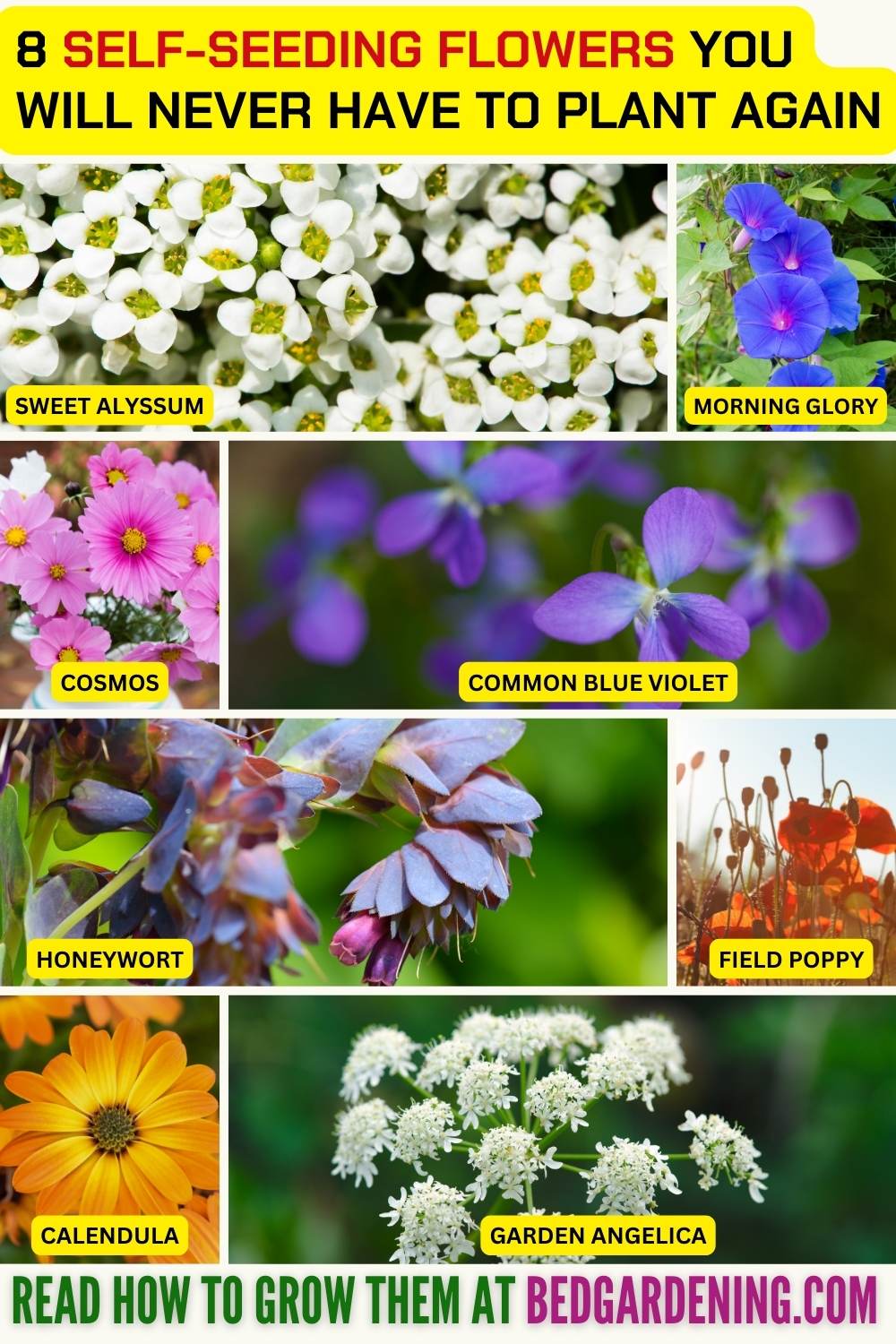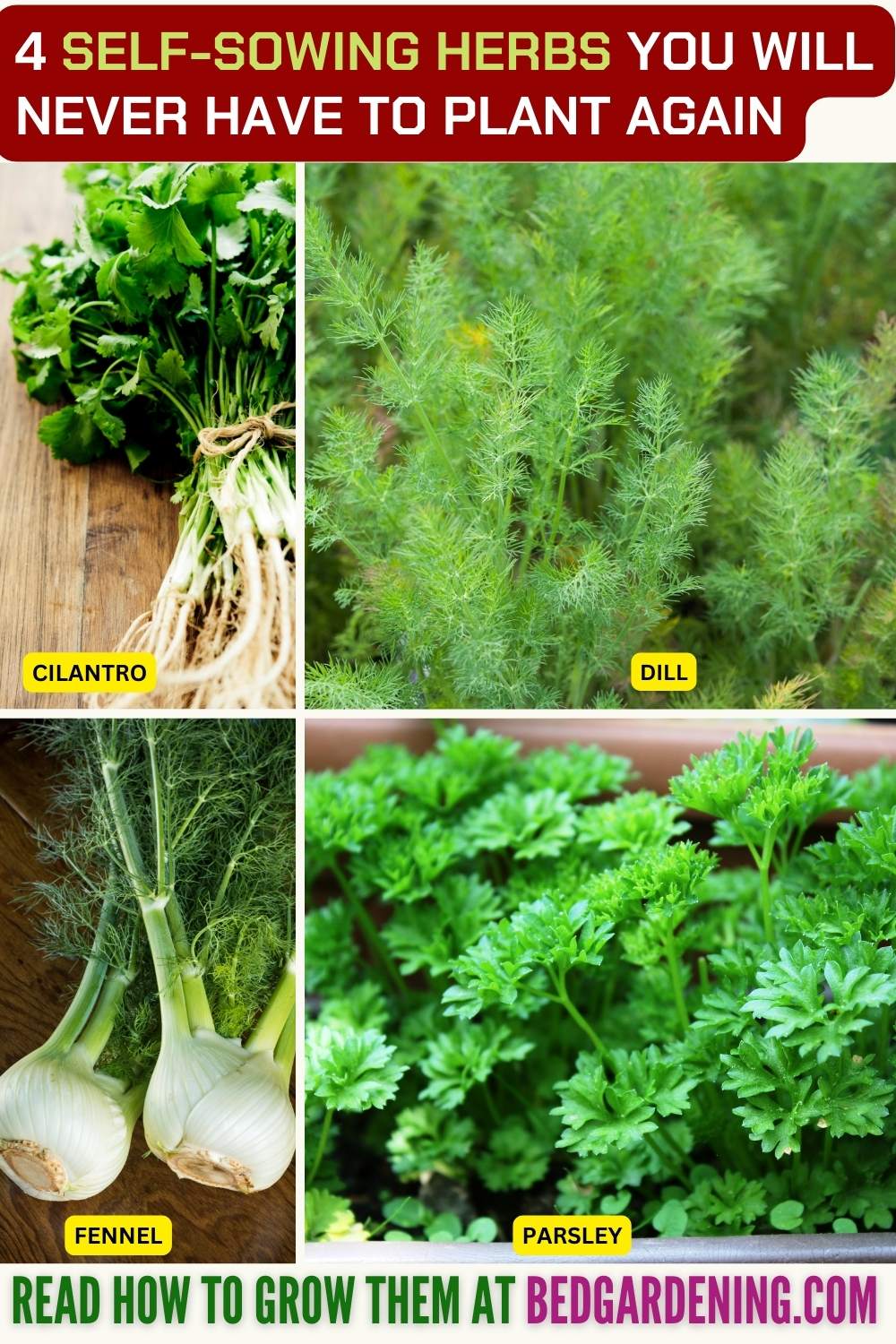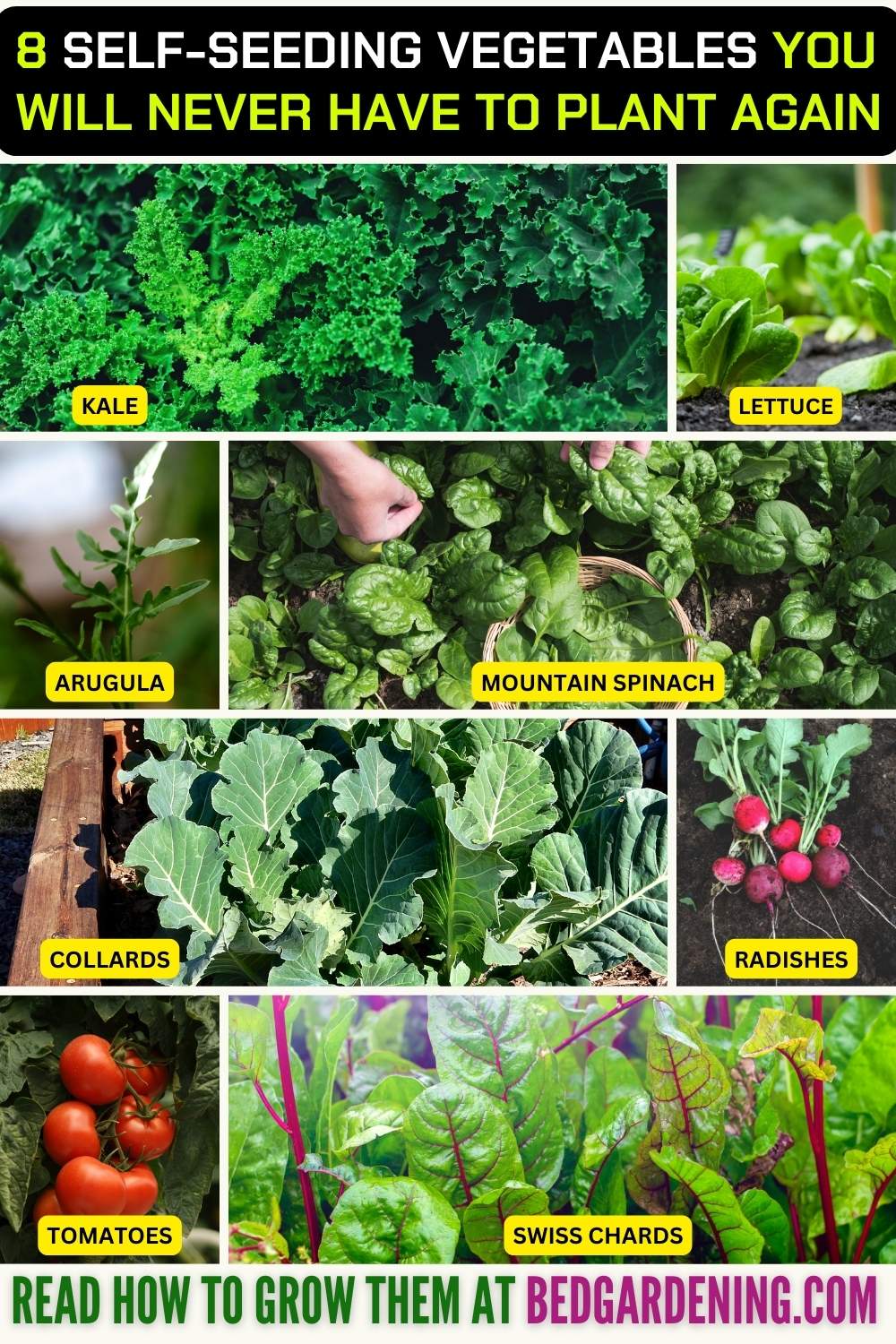If you are interested in recycling, repurposing, and reusing then you must be interested in growing self-seeding plants in your garden.
This is a perfect way of saving money as you don’t have to spend money on buying new plants and seeds for your garden. These plants reseed themselves and prepare a new crop in the next season.
What Are Self-Seeding Plants?

Self-seeding flowers, herbs and veggies drop their seeds, capsules, and pods on the ground in autumn and germinate on their own in spring. This is a natural process of reproduction of plants.
This process will save you the time of collecting or buying seeds and sowing them. Self-sowing plants save you money, time, and labor. These plants are pest resistant and need little attention. They need only soil for growing and germinating themselves.
Self-seeding plants will make your life easier as there is no need to store, harvest, and sow seeds. These varieties of plants easily adjust to your climate so you don’t have to care about the germination process of seeds.
Benefits Of Self-Seeding Plants
Whether you choose Self-seeding flowers or vegetables or herbs, all have valuable benefits. Following are the benefits of self-seeding plants in your garden.
1- SELF-SEEDER ACT LIKE PERENNIALS
Perennials grow for many years just like that self-seeders also grow again and again without sowing the seeds.
There is only one difference between perennials and self-seeders is that perennials grow in their permanent location where they are planted but self-seeders grow anywhere where their seeds are carried.
Perennials take many years to grow and divide. On the other hand, self-seeders fill the empty spaces in your garden very quickly.
2- SELF-SEEDERS ARE INEXPENSIVE
You have to spend money only once in buying the seeds of self-seeders. Once they are planted they grow again and again by producing seeds. Each self-seeder plant produces seeds 10 times more than a packet contains. It means a one-time investment is needed.
3- EACH NEW GENERATION OF SELF-SEEDERS EASILY ADAPTS EASILY IN YOUR GARDEN
A self-seeders are growing the whole time in your garden. That’s why the survivors are only those that can adapt to your environment. They adapt easily to the particular conditions of your yard or garden.
Each new generation of self-seeders can better adapt to the environment than the previous one. When you grow plants from the seed the new plant may have slight genetic changes. But in the case of self-seeders, the difference may be subtle.
Choosing Self-Sowers To Fill Your Garden
Never allow plants to invade your garden. There is a difference between invading and filling. Plants can’t draw a line so you have to create a line for them.
The right selection of self-sowing plants for your garden is crucial. You should use your plants wisely because occasionally they can become nuisance plants. This is an old technique to fill your garden with different flowers without much effort.
It is better to do some research before choosing the self-seeding garden plants. It is better to take all the information from any local nursery about such plants.
Some plants are invasive and become a problem for other plants in your garden. They take over the land and disturb other plants. You should think of a perfect plan before planting such invasive plants so you will not worry in the future or you will have to pull out these plants.
8 Self-Seeding Flowers You Will Never Have To Plant Again

Self-seeding flowering plants create an informal cottage garden look. They grow vigorously. To grow them you need little time and gardening skills.
Self-seeding plants never allow weeds to grow. Beautiful and attractive flowers are magnets for pollinators.
1- SWEET ALYSSUM
If you want to grow any empty areas along border fronts and edging in your garden then you must select a self-seeding flowering plant sweet alyssum. This is an annual plant with honey-scented white tiny flowers.
2- MORNING GLORY
Morning glory has heart-shaped leaves and trumpet-shaped flowers. The flowers are found in blue, pink, red, purple, and white. The flowers open in the morning. This is an annual blonde and it dies in the winter but self-sows in the spring.
3- FIELD POPPY
Usually, the color of the blooms is scarlet red but sometimes they appear in purple or white. The petals are papery with a black center and have a stunning look.
You can see the blooms from late spring to early summer. When the petals drop then there is a capsule filled with black seeds. The seeds from the capsule drop into the soil and germinate quickly.
4- COSMOS
Cosmos blooms from June to the first frost. This annual plant needs little maintenance. The maximum height of the cosmos plant is about 4 feet tall.
The flowers have 8 petals with yellow centers. Needle-like leaves are soft and feathery. Cosmos blooms are found in white, purple, and pink colors. You should leave spent flower heads on the cosmos plant so it will grow again.
5- COMMON BLUE VIOLET
This is a perennial wildflower that is a stemless plant. The leaves and blooms directly emerge from the underground rhizomes. Dark violet five petals with a white center look very beautiful. These flowers produce seeds that grow on their own.
6- CALENDULA
These lovely flowers are very beneficial because they are the best companion for cucumber tomatoes, asparagus carrots, peas lettuce, and more golden daisy-like flowers that attract many pollinators in your garden.
Bees, butterflies, and ladybugs like to eat aphids and other insects on these plants. The fragrance of leaves repels mosquitoes and asparagus beetles. Calendula reproduces itself in each season.
7- GARDEN ANGELICA
Tiny green and white flowers form an orb shape. These flowers add texture to your lower bed. This is a biennial plant that can grow up to 6 ft.
This plant needs ample space because the multi-branched stem holds many orbs. Garden Angelica reproduces itself in each season. The next generation will be ready for you in the next growing season.
8- HONEYWORT
Becauvoured nectar the pollinators are attracted by honeywort. The flowers are produced from spring to fall and are beloved by bees and human birds. Blue-green leaves are oval-shaped. Honeywort has rich purple flowers that produce large black seeds.
4 Self-Sowing Herbs You Will Never Have To Plant Again

9- CILANTRO
When summer is at its peak then the cilantro starts bolting to avoid this problem you should start planting early in the growing season. The flowers produce seeds and give you another crop.
When fall comes you can see the young seedlings start growing again for the next planting in a single season. This is a labor-free succession gardening that can save time in sowing the seeds.
Read: Grow Cilantro Indoors From Seeds
10- PARSLEY
Usually, parsley is grown as an annual plant. But you can take advantage of its self-growing property. In the first year, you can plant and harvest parsley normally.
In the next growing season let the plant produce flowers. The flowers of parsley will set their seeds for the third growing season. This self-sewing herb will quickly fill up your parsley patch.
Read: How To Grow Parsley From Clippings
11- DILL
This is an ornamental and aromatic annual herb. Dil has lacy and delicate green foliage. The blooms are already attractive to pollinators such as birds, bees, butterflies, and other beneficial insects.
The blooms produce seeds that will drop on the ground and turn into a new crop.
12- FENNEL
This is also a self-sowing herb. Fennel has attractive flowers so beneficial pollinators adore them. The maximum height of this plant is about 4 to 6 ft and the width is 1.5 to 3 ft.
Your crop is ready to harvest within 90 days. You must use loamy, moist, and well-drained soil for growing fennel plants a sunny area is perfect for growing this herb.
8 Self-Seeding Vegetables You Will Never Have To Plant Again

Self-seeding vegetables are those vegetables that grow back again in the next growing season by the seeds that drop in the last year’s plants. When you choose self-seeding vegetables for your garden, you spend less time planting and more time harvesting.
But you should know when to plant these self-growing vegetables and which are the best for your garden or backyard. Now we are going to share with you a short list of those vegetables that are self-growers.
13- KALE
This is a cold hardy vegetable that is highly nutritious. Kale produces leafy greens even at the temperature below 5°F. In winter, kale will go dormant but the roots of the plant remain intact.
When the temperature rises this plant comes back to life. This plant drops its seeds for the next year from long and slender seed pods.
14- LETTUCE
Lettuce can grow again and again after harvesting. To continue growth, you should snip off just a few leaves at a time per plant. In this way, you can harvest lettuce throughout the season.
Lettuce can’t tolerate warm weather; it likes to grow in a cold environment. The flowers of the lettuce help to continue the reproductive cycle and produce a new crop for the next year.
It is better to select a sunny location for lettuce plants but they can also grow in shady areas. Plenty of water is needed by your lettuce plants. Lettuce needs loamy, moist, well-drained, and acidic soil.
15- ARUGULA
This is an annual salad green that likes to grow in cold climates. You must harvest the young and tender leaves early in the summer because this plant can’t tolerate the high temperature of summer.
On hot days, arugula tends to bolt, if you want this plant to regrow then you must leave the flowers on the plant.
16- MOUNTAIN SPINACH
Orch or mountain spinach is a large leafy green vegetable. The taste of mountain Spanish is just like spinach. It can easily grow in warm weather.
The maximum height of mountain spinach is 6 to 8 ft and it comes in red, green, and white varieties. The flowerheads contain seed pods. Each pod has a single black seed. The seeds are helpful in the self-seeding process.
Read: How To Grow Spinach In Containers?
17- COLLARDS
Collards like to grow in moist, loamy, acidic, and well-drained soil. The size of the mature plant is two to three feet tall and wide. This is a large plant and self-seeder.
18- RADISHES
This is a fast-growing vegetable and needs little maintenance. Radishes are deep-rooted vegetables so your soil must be rock free. For growing self-seeding radishes, you should leave some of them in the ground.
The best time to plant radishes is spring and fall. Radishes can’t tolerate hot temperatures because of the warm climate.
Read: How To Grow Radishes From Scraps?
19- TOMATOES
The tomatoes drop the seeds on the soil when the temperature is warm the seeds will sprout. The roots of tomatoes will not disturb because they grow in the same position.
It may be possible that you could get a new variety or different color of tomatoes in the next self-seeded crop. Self-seeded tomatoes grow very fast and need little maintenance.
You should select non-hybrid varieties because the fruit of self-seeded tomatoes will be small if you choose hybrid varieties.
Keep Reading:
- How To Grow Tomatoes From Seeds In Containers
- How To Grow Cherry Tomatoes From Cherry Tomatoes?
- How To Grow Tomatoes In A Raised Bed?
20- SWISS CHARDS
This is a leafy green vegetable that can adjust to every environment. Swiss chard can continuously be produced in mild winter but in harsh winter this vegetable will not work as a self-seeder.
